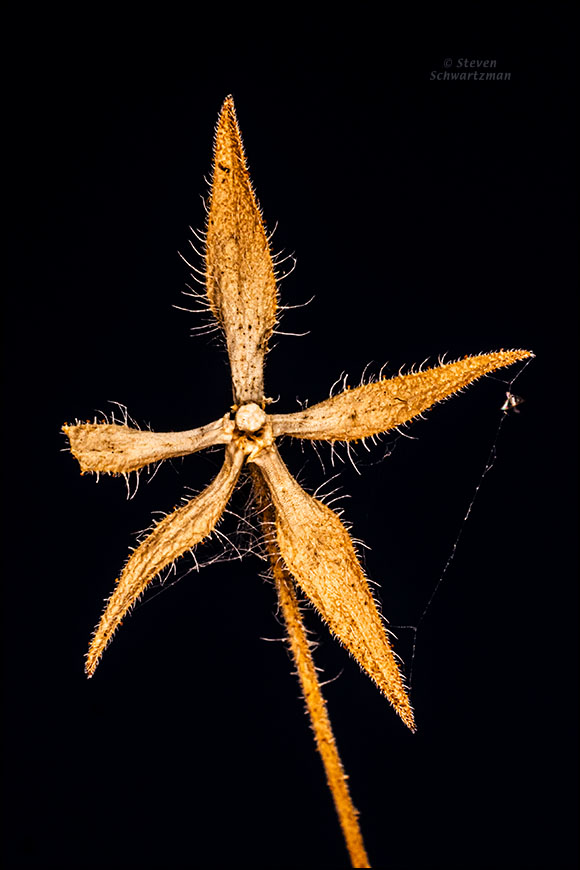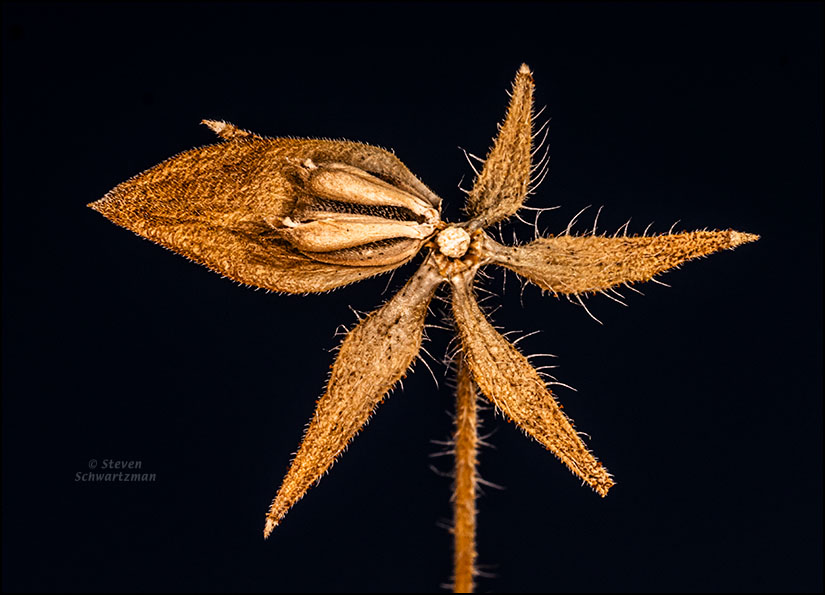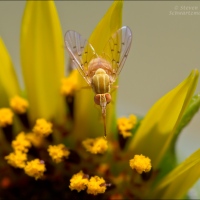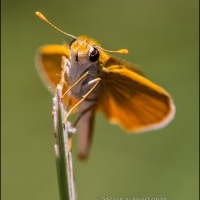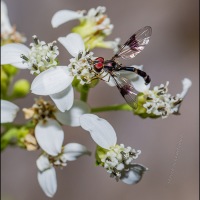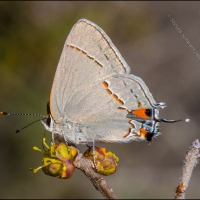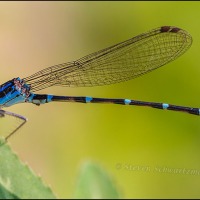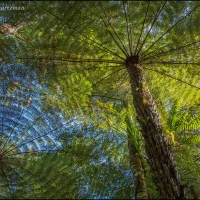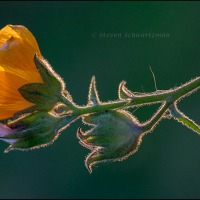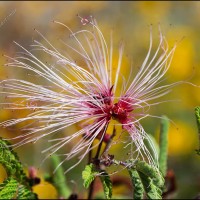Posts Tagged ‘nature’
A reprise 18 days later
On the morning of December 11th I had my first encounter for this season with frostweed’s ice phenomenon, which you’re welcome to look back at and read an explanation of. Yesterday morning marked my second encounter, which came on a much smaller scale. Where I’d had at least 20 frostweed plants (Verbesina virginica) with good ice formations to choose from the first time, yesterday offered very few active plants, and the ice formations on them were pretty small. Still, it was more than the 38° on our back yard’s outdoor thermometer promised when I checked it early in the morning, so I was glad to find any frostweed ice at all after I drove the half-mile downhill to Great Hills Park and walked down the slope to the frostweed plants I’ve been relying on for years to do their ice trick.
© 2023 Steven Schwartzman
Talayote pod
In July I featured a milkweed vine, Cynanchum racemosum var. unifarium, known as talayote, at the edge of Great Hills Park. In one post you saw flowers and buds and in the follow-up a tendril, a leaf, and a green pod. On September 14th I returned to the talayote vine and found two pods that had matured, opened, and released their seed-bearing fluff. You’re looking at one of them.
§
§ § §
§
I take the stance—and I hope you do, too—that when we confront a choice of programs for our governments to pursue, we examine not only the pros of each choice but also the cons. All too often the promoters of extreme energy policies present only the pros. That’s not right. One of the main problems with renewable energy sources like wind and solar is that they’re inherently unreliable: the wind can stop blowing for substantial periods, and the sun has the annoying habit of ducking over to the other side of the planet for half of each day and leaving solar cells in darkness.
With that in mind, here’s more from Robert Bryce’s 2020 book A Question of Power: Electricity and the Wealth of Nations.
Under an all-renewable scenario, ratepayers would also be stuck with big bills for electricity storage. A key reason why attempting to rely solely on renewables is so costly is that doing so would require enormous batteries to overcome seasonal fluctuations in wind and solar output. For instance, in California, wind- and solar-energy production is roughly three times as great during the summer months as it is in the winter. Storing summer-generated electricity and saving it until it’s needed in winter months would require batteries, batteries, and more batteries. According to a 2018 analysis done by Stephen Brick, an energy analyst at the Clean Air Task Force, a Boston-based energy-policy think tank, for California to get 80 percent of its electricity from renewables, the state would need about 9.6 terawatt-hours of storage.
It’s difficult to get a handle on what that number means. Therefore, Brick put it into more easily digestible terms: the number of Tesla Powerwalls that would be needed to store that quantity of electricity. (In 2015, Tesla, the same company that makes electric cars, began producing lithium-ion battery packs for use in energy-storage systems. The newest model, the Tesla Powerwall 2, can hold about 13 kilowatt-hours of energy.) By my calculations, storing the 9.6 terawatt-hours of electricity needed for California to get 80 percent of its electricity from renewables would require the state to install more than seven hundred million Powerwalls. That would mean every resident of California would need roughly eighteen Tesla Powerwalls. A full 100-percent-renewable electricity mandate would require even more batteries: some 36.3 terawatt-hours of storage, or about seventy-one Tesla Powerwalls for every resident. At roughly $6,700 per Powerwall, that much storage would cost each Californian about $479,000.
And let me point out that that’s in addition to the almost $100,000 that each American owes as a share of the national debt. People can propose whatever program they want, but if it’s not actually doable and affordable, what’s the point? Reality will stubbornly insist on being reality.
§
A few days after I wrote that, I came across a pertinent editorial in the Wall Street Journal titled “The Great Northeast Wind Bailout,” with sub-head “The politicians are already demanding more green corporate welfare.” Here’s the beginning:
If only the hot air blowing at the United Nations’ Climate Ambition Summit this week could be used to generate electric power. That would be especially convenient since Governors in the Northeast are lobbying the White House to bail out their states’ offshore wind projects, which have hit a gale of ballooning costs.
“Inflationary pressures, Russia’s invasion of Ukraine, and the lingering supply chain disruptions resulting from the COVID-19 pandemic have created extraordinary economic challenges,” wrote Govs. Kathy Hochul (N.Y.), Ned Lamont (Conn.), Phil Murphy (N.J.), Maura Healey (Mass.), Wes Moore (Md.) and Dan McKee (R.I.) to President Biden last week.
“Offshore wind faces cost increases in orders of magnitude that threaten States’ ability to make purchasing decisions,” they say. “Without federal action, offshore wind deployment in the U.S. is at serious risk of stalling because States’ ratepayers may be unable to absorb these significant new costs alone.”
And remember that “federal action” is a euphemism for “increased national debt.” You can read the whole editorial.
© 2023 Steven Schwartzman
Acorns that look different
On September 17th in my part of Austin I noticed a small tree with quite a few of what seemed to be acorns developing on it. What gave me pause was how different they appeared, especially when viewed from the side, as shown below, compared to the acorns I’m familiar with.
Aidan Campos of the Texas Flora group on Facebook quickly identified the species as Quercus fusiformis, known by names that include escarpment live oak, plateau live oak, hill country live oak, Texas live oak, scrub live oak, and plateau oak.
In the top picture, also notice what appears to be the work of a leafcutter bee.
§
§ § §
§
A September 15th article in the New York Post offers yet another depredation of that destructive ideology called “equity”:
Portland, Oregon, public schools are looking to introduce “equitable” grading practices — and erasing excellence in the process.
The troubled progressive city’s school district is toying with proposals to make grades more even across the board by no longer flunking underperformers and increasing the value of “non-academic factors” in the grading process.
Among the new guidelines: no more zeroes, no more 100-point scale, no more points docked for late work and no more grade penalties for kids who cheat.
According to a memo from the district, the changes were inspired by concern over racial disparities in grades.
The district’s Chief Academic Officer Kimberlee Armstrong told KGW8 News that the changes are “about fairness,”
“It’s about reducing bias, it’s about considering diverse backgrounds and needs of students,” she said.
You can read the full disheartening article.
At the same time:
“Portland, Oregon, is in the middle of a public safety crisis,” [a Manhattan Institute] report reads. “What sets Portland apart are the limits on its capacity to respond to these issues with the traditional tools of the criminal justice system and, in particular, its capacity to use the police.”
The PPB [Portland Police Bureau] took more than 20 minutes to respond to high-priority calls, more than 50 minutes to respond to medium-priority calls, and more than one and a half hours to respond to low-priority calls as of July, according to the report.
“Like other major cities, Portland, Oregon, has experienced a surge in crime and disorder over the past three years,” the report reads. “Unlike other major cities, Portland is uniquely ill-equipped to deal with this problem, because its police department is uniquely understaffed.”
The city’s shootings spiked after Floyd’s death, reaching a 26-year record in 2020 and setting all-time homicide records in 2021 and 2022. Portland followed the “defund the police” movement, slashing $15 million from the PPB’s budget and cutting the number of sworn officers by 8 percent.
“Property crimes have surged,” the report reads. “Public disorder, in the form of camping and public drug use, is rampant.”
The year following Floyd’s death, one in every 1,000 black Portland residents was murdered.
You can read that disheartening article in full as well.
© 2023 Steven Schwartzman
Easily recognizable seed head remains
Sometimes—I should probably say often—it’s hard to identify a plant from its dry remains. One exception in Austin is Texas yellow star, Lindheimera texana. Here are the remains of two seed heads that I immediately recognized in Schroeter Neighborhood Park on June 27th. If you want to see what the fresh flowers are like, take a look.
§
§ § §
§
Biology faces a grave threat from “progressive” politics that are changing the way our work is done, delimiting areas of biology that are taboo and will not be funded by the government or published in scientific journals, stipulating what words biologists must avoid in their writing, and decreeing how biology is taught to students and communicated to other scientists and the public through the technical and popular press. We wrote this article not to argue that biology is dead, but to show how ideology is poisoning it. The science that has brought us so much progress and understanding—from the structure of DNA to the green revolution and the design of COVID-19 vaccines—is endangered by political dogma strangling our essential tradition of open research and scientific communication. And because much of what we discuss occurs within academic science, where many scientists are too cowed to speak their minds, the public is largely unfamiliar with these issues. Sadly, by the time they become apparent to everyone, it might be too late.
That’s the summary of an important article in the July/August issue of Skeptical Inquirer, “The Ideological Subversion of Biology,” by Jerry A. Coyne and Luana S. Maroja. Here are the first two paragraphs of the article:
We’re all familiar with the culture wars that pit progressive Leftists against centrists and those on the Right. In the past, those skirmishes dealt with politics and sociocultural issues and in academia were restricted largely to the humanities. But—apart from the “sociobiology wars” of the seventies and our perennial battles against creationism—we biologists always thought that our field would avoid such struggles. After all, scientific truth would surely be immune to attack or distortion by political ideology, and most of us were too busy working in the lab to engage in partisan squabbles.
We were wrong. Scientists both inside and outside the academy were among the first to begin politically purging their fields by misrepresenting or even lying about inconvenient truths. Campaigns were launched to strip scientific jargon of words deemed offensive, to ensure that results that could “harm” people seen as oppressed were removed from research manuscripts, and to tilt the funding of science away from research and toward social reform. The American government even refused to make genetic data—collected with taxpayer dollars—publicly available if analysis of that data could be considered “stigmatizing.” In other words, science—and here we are speaking of all STEM fields (science, technology, engineering, and mathematics)—has become heavily tainted with politics, as “progressive social justice” elbows aside our real job: finding truth.
The article goes on to “give six examples of how our own field—evolutionary and organismal biology—has been impeded or misrepresented by ideology. Each example involves a misstatement spread by ideologues, followed by a brief explanation of why each statement is wrong.” The six ideological misstatements are:
- Sex in humans is not a discrete and binary distribution of males and females but a spectrum.
- All behavioral and psychological differences between human males and females are due to socialization.
- Evolutionary psychology, the study of the evolutionary roots of human behavior, is a bogus field based on false assumptions.
- We should avoid studying genetic differences in behavior between individuals.
- Race and ethnicity are social constructs, without scientific or biological meaning.
- Indigenous “ways of knowing” are equivalent to modern science and should be respected and taught as such.
You’re welcome to read the full article, from which I,
a non-scientist, learned some interesting things about science.
© 2023 Steven Schwartzman
Leander Ready Mix
You’d hardly think of an industrial site like Leander Ready Mix on US 183 as a good place to see wildflowers. Nevertheless, I stopped there on May 27th after I saw plenty to photograph on the fringe of property adjacent to one end of the business’s parking lot. The tall purple inflorescences are horsemints (Monarda citriodora). Across the back you have a dense colony of basket-flowers (Plectocephalus americanus). The yellow flower heads with brown centers are coreopsis (Coreopsis tinctoria). The low mound of light green plants in the center promises blooms by the end of the summer or the beginning of fall; we’re talking about Maximilian sunflowers (Helianthus maximiliani).
A little earlier I’d stopped nearby for the first time ever along a recently built road, Seward Junction Loop. In the picture below, one of a bunch I took there, you see more firewheels (Gaillardia pulchella) than anything else, along with bits of Texas thistle (Cirsium texanum), horesemints, and prairie verbena (Glandularia bipinnatifida).

§
§ §
§
As a field botanist, I am sometimes asked about the “correct” pronunciation of scientific (Latinate) names. My answer is: “The right way to pronounce them is loudly and with great confidence, so that everyone will believe you know what you are talking about.” This has always worked for me.
— Faith Anstey, letter in the 3 June 2023 issue of New Scientist.
© 2023 Steven Schwartzman
Texas thistle buds
On May 27th at an undeveloped property adjacent to the Starbucks in the rapidly growing town of Liberty Hill I found bits of nature to photograph. Among them were stages of Texas thistles, Cirsium texanum. Above you see a green lacewing egg attached to the bud of one. Below, an opening bud nudges a decomposing seed head, with both on gracefully curved stalks.
© 2023 Steven Schwartzman
Verdant
Look how lush the maidenhair ferns (Adiantum capillus-veneris), inland sea oats (Chasmanthum latifolium), and other plants were along the trail between Springfield Park and McKinney Falls State Park in southeast Austin on May 21st. Thanks to recent rain, drops were still falling from the roof of the dark little “grotto” at the center. Below you see what an adjacent stretch of Onion Creek was looking like. The large tree with the interesting roots at the right is a bald cypress (Taxodium distichum).
© 2023 Steven Schwartzman
Cloudscape
My last stop in our seven-hour wildflower chase on March 13th wasn’t for wildflowers. It was for these clouds I’d been eyeing for some time after we turned north from Nixon on FM 1117 and headed for home.
✦
✦ ✦ ✦
✦
A recent post made me aware of Harry Watrous (1857–1940), a traditional American figurative painter who didn’t like modernism. Turning from style to message, however, we find him very modern in the message he conveyed in a painting from around 1913, “The Drop Sinister—What Shall We Do with It?” The first part of the title refers to the “one drop rule” from the benighted days of American slavery and racism when white supremacists considered a person with any black ancestry at all, even as little as one drop of blood, to be black and therefore to be looked down upon and mistreated.
The painting shows three people, presumably a family: a light-skinned black man on one side, a seemingly white woman and blond-haired girl together on the other side. As Wikipedia notes:
It is said to be the first known portrait of an American interracial family. The father wears a clerical collar and holds a Christian newspaper in his hand; on the wall [between the husband on the left and the wife and daughter on the right] is a portrait of Abraham Lincoln and a quotation, “And God said, Let us make man in our own image after our likeness.”
The painting caused a stir when it was exhibited at the National Academy of Design and at the Century Club in New York. “Harry W. Watrous preaches and paints well an interesting sermon on the negro question in The Drop Sinister,” commented American Art News, which also called it “one of his best canvases.” This “study in the fruits of miscegenation…caused an extraordinary amount of discussion, residents of one typically Southern city threatening to wreck the art museum if it was shown there.”
The painting appears to depict a mixed marriage, which was illegal in many states at the time. The Crisis, the N.A.A.C.P. journal edited by W.E.B. DuBois, had a different idea about what was going on in the picture:
The people in this picture are all “colored”; that is to say the ancestors of all of them two or three generations ago numbered among them full-blooded Negroes. These “colored” folk married and brought to the world a little golden-haired child; today they pause for a moment and sit aghast when they think of this child’s future.
What is she? A Negro? No, she is “white.” But is she white? The United States Census says she is a “Negro.” What earthly difference does it make what she is, so long as she grows up a good, true, capable woman? But her chances for doing this are small! Why?
Because 90,000,000 of her neighbors, good Christian, noble, civilized people are going to insult her, seek to ruin her and slam the door of opportunity in her face the moment they discover “The Drop Sinister.”
The reference to people threatening to wreck an art museum if “The Drop Sinister” was shown there reminds us that in at least one respect nothing has changed in the century since Harry Watrous created his painting. We still have zealots who feel justified in attacking, even with physical violence, anyone who has ideas different from any of the zealots’ cherished beliefs.
The most recent criminal activity of that sort I’m aware of took place at the University of California, Davis on March 14th, when woke activists rioted to protest a speech by Charlie Kirk, founder of Turning Point USA. The rioters (and unfortunately many students on campus) believe Charlie Kirk is “hateful” in believing, for example, that biological men shouldn’t be allowed to compete against women in athletics. Ironically, the zealots have pushed beyond the one-drop rule of racial segregation and now follow a zero-drop rule: anyone born with not even a single drop of female blood can demand to be treated as a woman.
© 2023 Steven Schwartzman
Aotearoa comes to Padre Island
June 2nd was the first night we spent away from home in the two-and-a-quarter years since the pandemic hit. We drove 200 miles south from Austin to see the sea, or more properly the Gulf of Mexico, which is a branch of the Atlantic Ocean. Our first nature stop on the coast was the Padre Island National Seashore, where both of these dune scenes reminded me of Aotearoa, the Māori name for New Zealand that supposedly means ‘the land of the long white cloud.’ I took these pictures two minutes apart, and although a long white cloud inhabits each one, I went for different photographic treatments.
✳︎
✳︎ ✳︎ ✳︎
✳︎
Speaking of places with beaches, in a feature that aired on September 27, 2021, Sharyl Attkisson looked at the potential Puerto Rico has to supply pharmaceuticals domestically and thereby lessen the heavy dependence of the United States on foreign countries, most notably China, for our medicines. The nine-minute video focuses on two immigrants, one from Viet Nam and the other from the Dominican Republic, who are opening a pharmaceutical plant in Aguadilla, Puerto Rico. Credit also goes to the mayor of that town, who shortened the process of getting all the required approvals down to a single day from what would typically take a year (why?!). Have a look.
© 2022 Steven Schwartzman
Unaccustomed clouds
While driving back on May 14th from a visit to friends in the foreign country that south Austin sometimes seems to those of us from north Austin, we noticed these unaccustomedly dramatic clouds that I believe meteorologists classify as mammatus. Credit the picture to my iPhone, the only camera I had with me.
§
§ § §
§
And speaking of the atmosphere, here are four stories about the environment that the Good News Network recently featured:
World’s First Ocean-Assisted Carbon Removal Plant Launched in Hawaii
Scientists Power a Computer Using Only Algae and Daylight to Make the Electricity
Bronx Housing Complex Comes With Giant Machine Stomach to Turn All Food Waste Into Fertilizer
New Google Headquarters Uses ‘Dragonscale’ Solar Panels to Capture Sunlight From All Angles
© 2022 Steven Schwartzman





